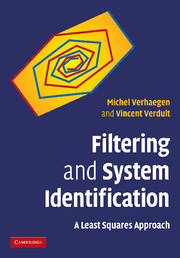Book contents
- Frontmatter
- Contents
- Preface
- Notation and symbols
- List of abbreviations
- 1 Introduction
- 2 Linear algebra
- 3 Discrete-time signals and systems
- 4 Random variables and signals
- 5 Kalman filtering
- 6 Estimation of spectra and frequency-response functions
- 7 Output-error parametric model estimation
- 8 Prediction-error parametric model estimation
- 9 Subspace model identification
- 10 The system-identification cycle
- References
- Index
6 - Estimation of spectra and frequency-response functions
Published online by Cambridge University Press: 14 January 2010
- Frontmatter
- Contents
- Preface
- Notation and symbols
- List of abbreviations
- 1 Introduction
- 2 Linear algebra
- 3 Discrete-time signals and systems
- 4 Random variables and signals
- 5 Kalman filtering
- 6 Estimation of spectra and frequency-response functions
- 7 Output-error parametric model estimation
- 8 Prediction-error parametric model estimation
- 9 Subspace model identification
- 10 The system-identification cycle
- References
- Index
Summary
After studying this chapter you will be able to
use the discrete Fourier transform to transform finite-length time signals to the frequency domain;
describe the properties of the discrete Fourier transform;
relate the discrete Fourier transform to the discrete-time Fourier transform;
efficiently compute the discrete Fourier transform using fast-Fourier-transform algorithms;
estimate spectra from finite-length data sequences;
reduce the variance of spectral estimates using blocked data processing and windowing techniques;
estimate the frequency-response function (FRF) and the disturbance spectrum from finite-length data sequences for an LTI system contaminated by output noise; and
reduce the variance of FRF estimates using windowing techniques.
Introduction
In this chapter the problem of determining a model from input and output measurements is treated using frequency-domain methods. In the previous chapter we studied the estimation of the state given the system and measurements of its inputs and outputs. In this chapter we do not bother about estimating the state. The models that will be estimated are input–output models, in which the state does not occur. More specifically, we investigate how to obtain in a simple and fast manner an estimate of the dynamic transfer function of an LTI system from recorded input and output data sequences taken from that system. We are interested in estimating the frequency-response function (FRF) that relates the measurable input to the measurable output sequence. The FRF has already been discussed briefly in Section 3.4.4 and its estimation is based on Lemma 4.3 via the estimation of the signal spectra of the recorded input and output data. Special attention is paid to the case of practical interest in which the data records have finite data length.
Information
- Type
- Chapter
- Information
- Filtering and System IdentificationA Least Squares Approach, pp. 178 - 206Publisher: Cambridge University PressPrint publication year: 2007
